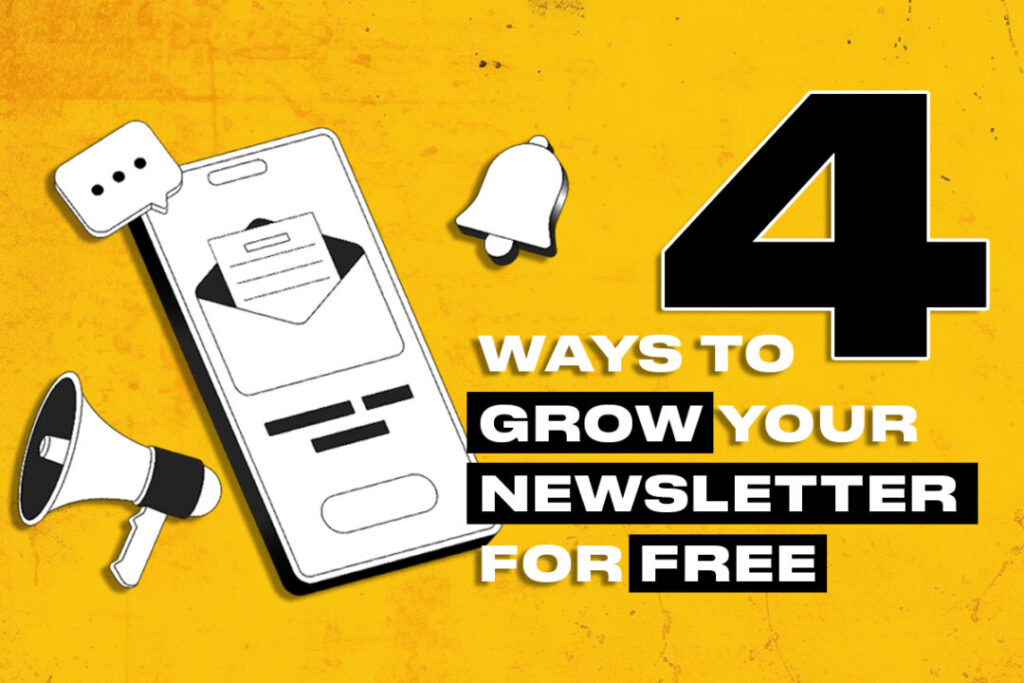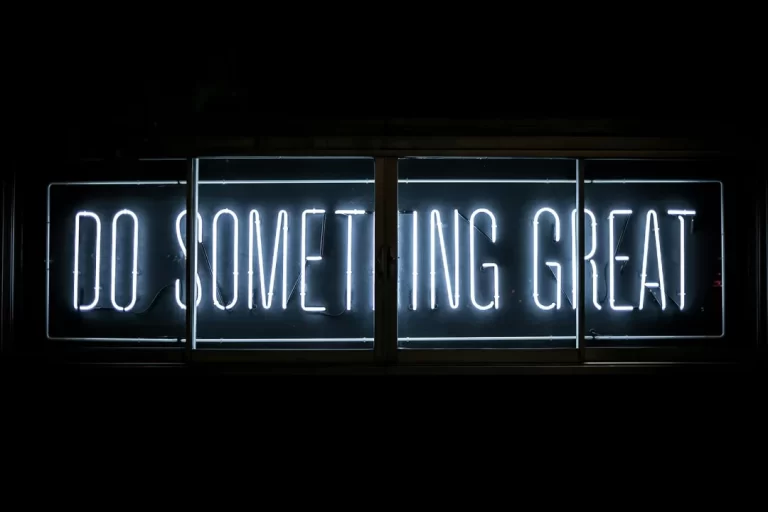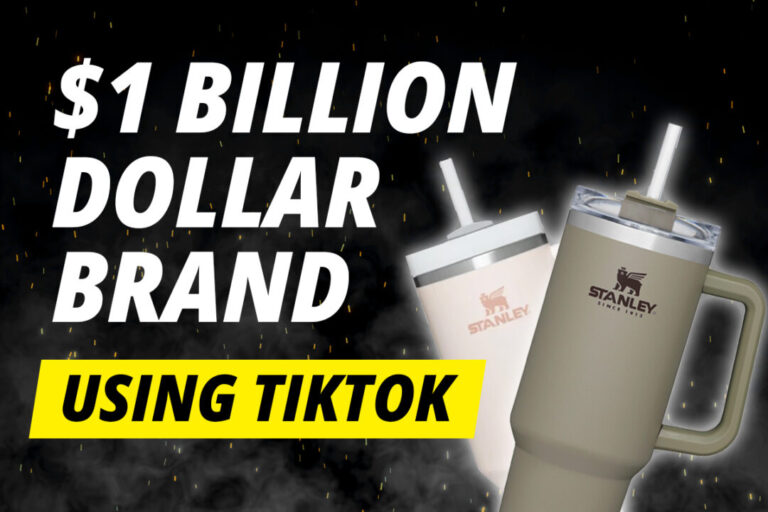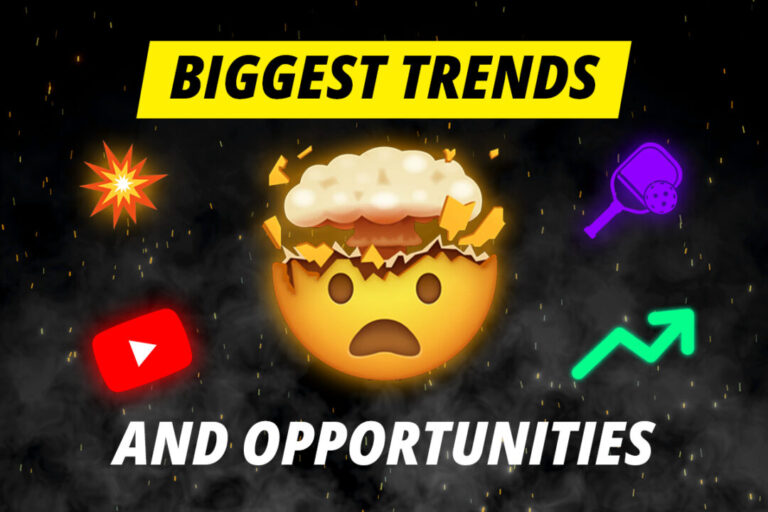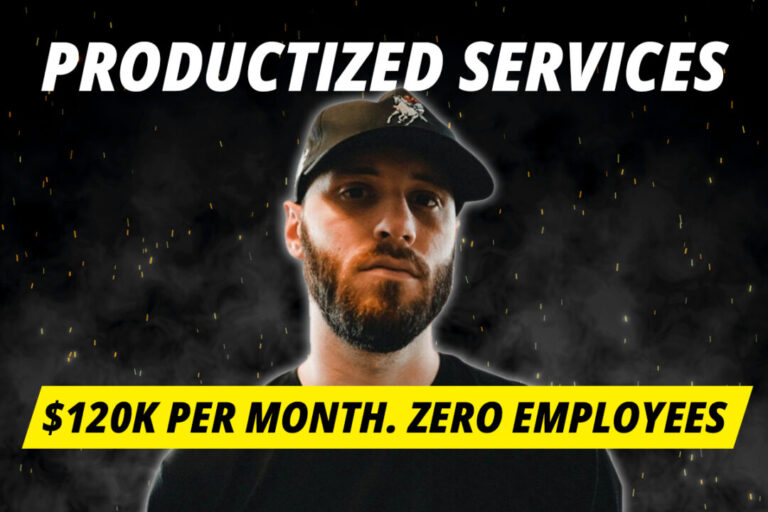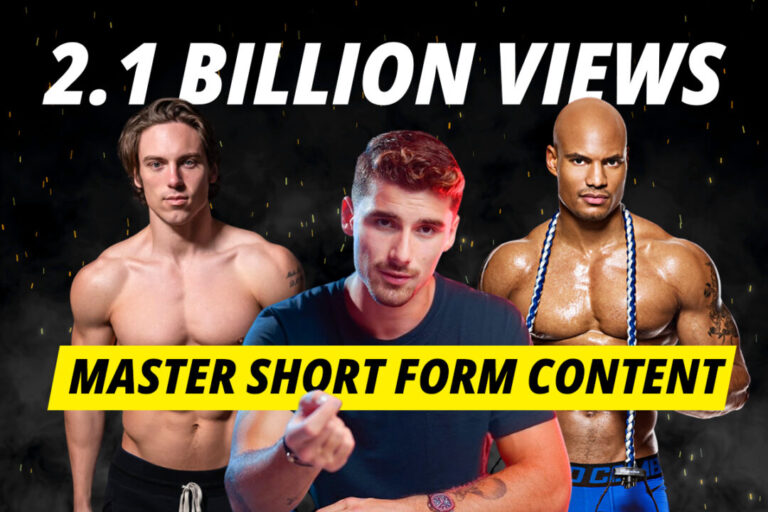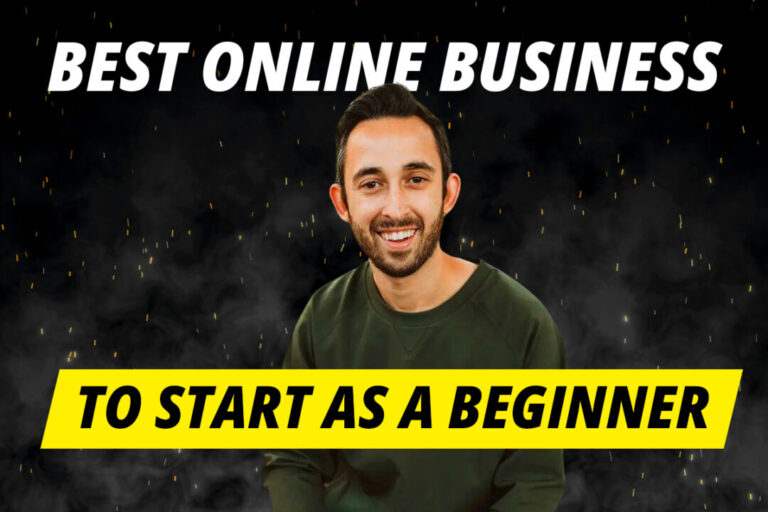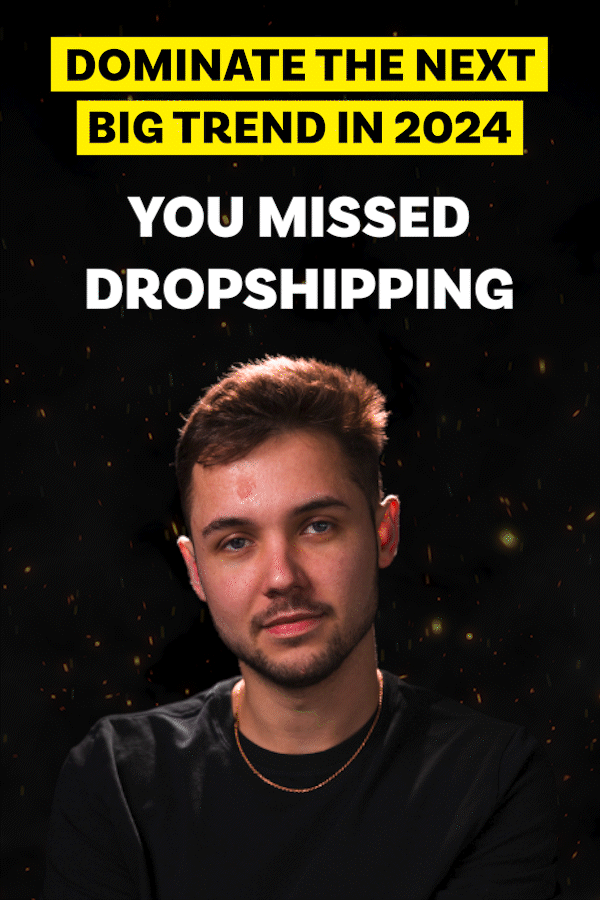Starting a newsletter is, hands down, one of the best side hustles for beginners. It’s free to start and has the potential to grow into a multi-million-dollar business.
Starting a newsletter seems a no-brainer, but most people don’t start because they think they can’t grow without money or an existing audience.
This couldn’t be further from the truth.
In the last 9 months, I grew the WGMI newsletter from 0 to 60k subscribers. During that time, I’ve tried and tested 25+ growth strategies. In this resource, I’ll share the 4 most effective strategies you can use to grow your list.
The best thing about these strategies is that you don’t need an audience and they are completely free.
Literally, anyone can use them. Yes, that includes YOU.
There are a million ways you can grow your newsletter. You’ll only figure out the best way if you experiment. Sample as many tactics as you can, and you’ll quickly see which one is best for finding your audience. It takes a bit of time to see results, so try these tactics for at least one month before deciding to quit or double down.
Before you start… you’ll need this
This one simple mindset shift helped me take my newsletter growth to another level:
Having access to someone’s email address is a privilege. An email address is a valuable asset, and you must earn it.
How do I earn this privilege?
To earn someone’s email address, you must convince them that you are worthy of their time. In other words, they must believe the value you provide outweighs the inconvenience you cause by cluttering up their inbox.
The best way to convince someone that you will provide extreme amounts of value is to create a lead magnet.
What is a lead magnet?
A lead magnet is like a little gift you give someone in return for their email address. In return for a cool freebie like a helpful guide or checklist, people are more willing to say “yes” when asked for their email address.
Here’s an example (my most popular lead magnet)
At WGMI, our target audience is anyone who wants to learn how to use AI and tech to make money online. Our most successful lead magnet is a resource that shares 100+ AI business ideas and provides all the information someone needs to start each business.
I’ve collected over 10,000 email addresses using that lead magnet alone.
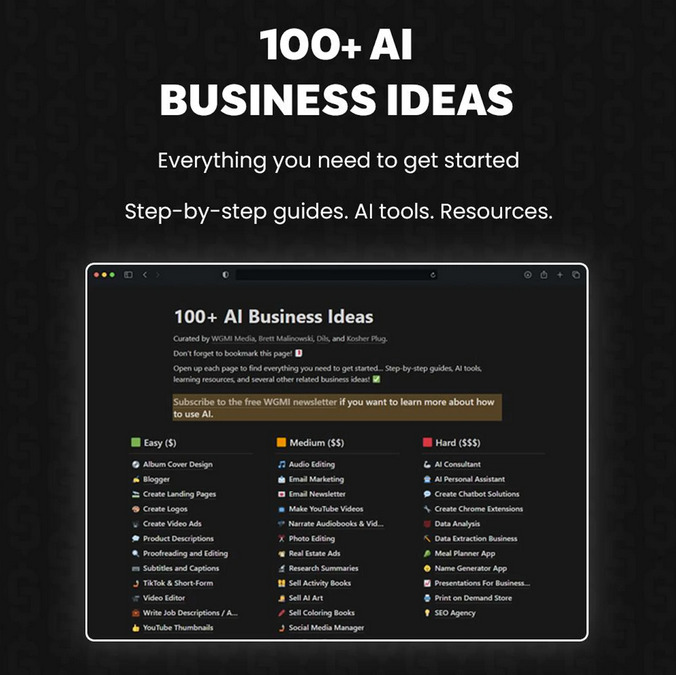
How do I create a lead magnet?
Luckily for you, I’ve created a comprehensive tutorial on how to make a lead magnet in Beehiiv. This free tutorial includes:
- How to brainstorm infinite high-value lead magnet ideas ✅
- How to create the lead magnet itself ✅
- How to set the lead magnet up in Beehiiv to collect emails ✅
- How to create an email automation that automatically sends out your lead magnet ✅
Strategy 1: Message friends, message strangers
This is the most effective and reliable strategy for anyone who has less than 100 subscribers.
Step 1: Message friends
The very first thing you should do is message all your friends, family, and colleagues. Let them know you have a newsletter and that they should subscribe.
Call in every favor you can. Getting off the ground with a newsletter is no joke.
Step 2: Message strangers (and make them your friends)
If you’ve run out of friends to ask, it’s time to make some more.
The second thing you need to do is send a message to everyone you can find in your target audience.
The trick here is simple: Make a connection first. Then, and only then, invite them to join your newsletter.
Here’s how to do it.
Where should I message people?
If your target audience is not business-related (e.g. news, hobbies, sports newsletters) then message people on Twitter (I refuse to call it X).
If your target audience is people in business (e.g. marketing / business ideas / real estate newsletters) then message people on LinkedIn AND Twitter.
How to message people on Twitter
Step 1 (Find the most popular people in your niche): Find all the most influential creators on Twitter and add them to a “List”.
Step 2 (Find people to message): Go to the most recent posts from the influencers on your List. Open up the comments on the Tweet, and message every single person who has commented on that Tweet. These people will be much more likely to respond to your DMs.
Step 3 (Make a connection): Your mission is to make this person your friend. That means your first goal is to have a normal conversation. Spark a conversation, and even try to organize a call with them. Here are some things you could say / ask:
- Hey there! I noticed you’re really into [shared interest]. What are your thoughts about [insert conversation topic]?
- I can see from your profile you’re super knowledgeable about [topic]… what are your thoughts on [insert conversation topic]?
- I LOVE your post on [recent post]. I’d love to hear more about your approach to content.
- Hey hey! I’m trying to learn as much about the [niche] space as possible… would you be down for a chat sometime? Trying to meet as many like-minded people as I can
Step 4 (Shoot your shot): After you’ve built a rapport with the person (minimum of 3-4 days after your first conversation) ask them if they would consider subscribing to your newsletter.
How to message people on LinkedIn
- Step 1 (Find a LinkedIn Group): Find a LinkedIn Group that is relevant to your niche.
- Step 2 (Engage in the Group): Start engaging in conversations and sharing your expertise and knowledge. Ask questions to spark conversations. Do NOT shill your newsletter yet.
- Step 3 (Message people): After having a few conversations with people in the LinkedIn Group, add them and start making a connection (see step 3 in the Twitter guide above).
- Step 4 (Shoot your shot): After establishing a connection with someone, ask them to consider subscribing to your newsletter.
It’s going to be a grind (enjoy it)
Your first 1,000 followers are going to be a grind, but it gets easier (I promise).
This strategy of messaging strangers is highly unscalable, but you have to do everything in your power to get the momentum going.
I LOVE this method for three reasons:
- It’s effective (i.e. lots of new subscribers)
- You’ll make actual friends and connections that can help you on your journey
- You’ll learn a lot. Use this time as an opportunity to learn as much as you can about your topic. You’ll learn everything about your audience’s problems and desires, and you can craft content that helps them solve it.
Shoot your shot
If you want to practice this method, go ahead and shoot me a message on Twitter. Let’s connect!
Strategy 2: Reddit
The quickest way to get your first 500 subscribers is on Reddit.
What is Reddit?
Reddit is basically a collection of forums on every single topic you can imagine.
Want to find people interested in wedding planning? Here’s a subreddit with over 364k people.
Maybe you’re looking for people who like to fix cars. Here’s 1.2m people.
It makes Reddit the perfect place to find your target audience (i.e. people who might subscribe to your newsletter).
What makes Reddit so good for finding subscribers?
On Reddit, good content rises to the top. The amount of followers you have is irrelevant. It is, by far, your best chance of going viral quickly.
My first post on Reddit got over 600 upvotes, 100k views and culminated in around 100 new subscribers for my email list. From ONE post.

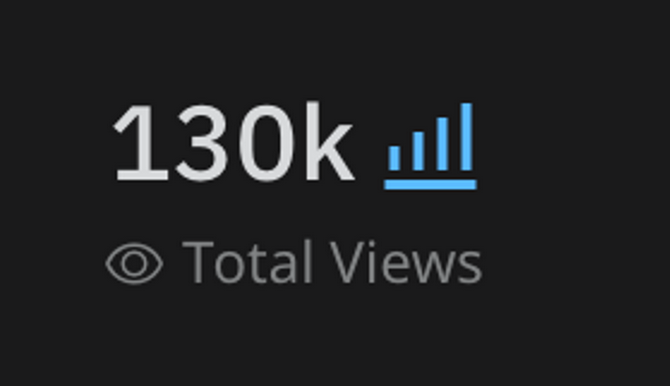
Since my first post, I’ve used Reddit to get millions of views, tens of thousands of upvotes and thousands of newsletter subscribers. Lucky for you, I’m sharing the exact strategy I used:
How to get newsletter subscribers on Reddit
- Step 1 (Find relevant subreddits): Find subreddits about your desired topic. To do that, search your niche in Reddit and go to the communities tab.
- Step 2 (Read the subreddit’s rules): Read their rules to check whether you’re allowed to post a link promoting your newsletter.
- Step 3 (Create high-value content): You’ll only go viral on Reddit if your content is good. So put some time into making content that shares tips, tricks, or a breakdown of recent news in the industry.
💡 Side note: Reddit HATES anything that sounds commercial, so make your post sound as human and personal as possible. Instead of saying “Here are 10 top tips for copywriting that will 10x your sales”, say something like: “I spent 3 years as a copywriter before becoming a content writer... and I still do some copy jobs on the side. Here are 10 tips I learned along the way…”.
- Step 4 (plug your newsletter, subtly): After dropping your almighty value bombs, add a subtle plug for your newsletter. Make it sound personal and casual. You could say something like, “If this was helpful, it would mean a lot if you subscribed to my newsletter. I love researching and writing about this stuff, and I share everything I find in my newsletter”.
Examples of this strategy in action
If you want to see how I used this strategy for myself, here are 4 real-life examples:
Example 1 / Example 2 / Example 3 / Example 4.
Strategy 3: Recommendations
When you reach 1k subs and you’re growing by around 10-20 subs per day, this strategy is an absolute no-brainer.
We’re going to use Beehiiv’s ‘Recommendations’ tool.
💡 I use Beehiiv because, in my experience, it’s the best platform to grow your newsletter. It’s ridiculously easy to get set up in there, and it has all the tools you need to scale to hundreds of thousands of subscribers.
What is the Beehiiv Recommendations tool?
Beehiiv Recommendations are, well, recommendations from other newsletters on Beehiiv. Here’s how it works:
- Any newsletter on Beehiiv can ‘recommend’ any other newsletter on Beehiiv.
- When someone subscribes to your newsletter, a pop-up appears on their screen immediately after subscribing. That pop-up contains a list of all your recommendations.
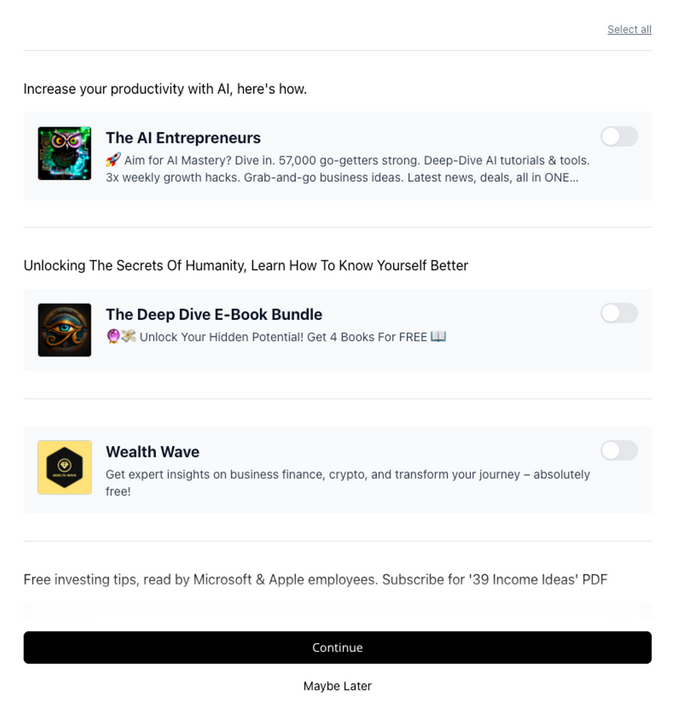
- Your new subscribers can browse through your recommendations and choose whether they also want to subscribe to them.
2 reasons you should be using Beehiiv Recommendations
- If you can convince other popular newsletters to recommend your newsletter, you’ll get LOTS of new subscribers for free.
- The subscribers from Beehiiv Recommendations are usually high quality (i.e. they regularly open and click emails). It’s direct access to a pool of people who already know about and use email newsletters.
How do I find and set up Recommendations?
Life is all about give and take. To get other newsletters to recommend you for free, you’ll need to offer to recommend them. Here’s how to do it.
Step 1 (Find other newsletters): You need to find other newsletters in your niche that have a similar subscriber amount to you.
- To find other newsletters, you can browse LetterGrowth. Go to the ‘By Wanted Category’ and then choose a niche that is relevant to yours.
- The newsletters you recommend should have a similar target audience to yours… it’s unlikely that someone subscribing to a dog training newsletter would be interested in subscribing to an SEO tips newsletter. See what I’m saying?
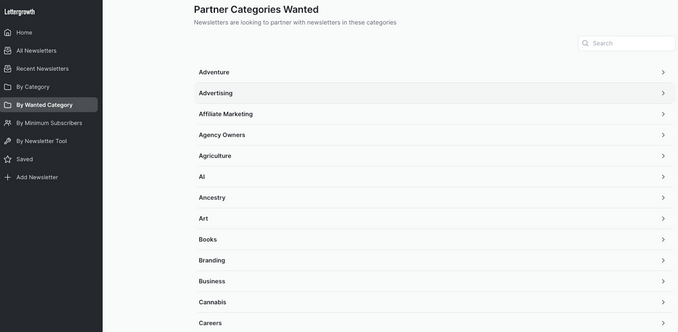
- Details about your newsletter
- The number of followers you have (send a screenshot of your Beehiiv dashboard to prove it)

- The number of subscribers you got in the last week (send a screenshot of the data in Beehiiv to prove it)
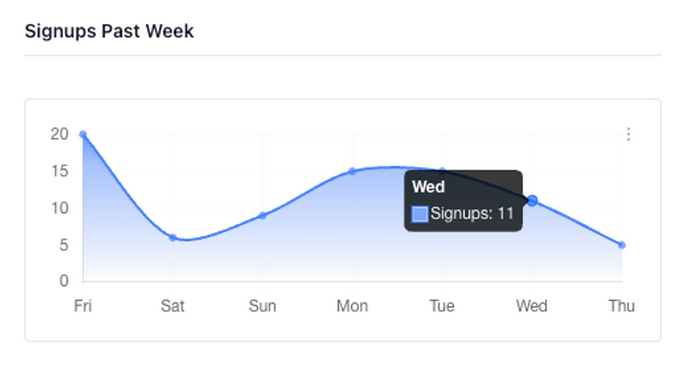
- Explain why you think your audience will be interested in subscribing to their newsletter
Template email:
Hi there
I just read a couple editions of your newsletter and absolutely love it!
I also run a newsletter called [YOUR NEWSLETTER NAME] about [YOUR NICHE].
While reading your newsletter, I realized my audience would find your newsletter super valuable. My audience is interested in [YOUR AUDIENCE’s INTERESTS].
Would you be interested in partnering up to recommend each other’s newsletter on Beehiiv? I have [NUMBER] subscribers and we’re getting around [NUMBER] new subscribers every day.
[SCREENSHOT OF SUBSCRIBER NUMBER IN BEEHIV][SCREENSHOT OF SIGNUPS PAST WEEK IN BEEHIIV]
Let me know if you have any questions… I’m excited for this collab!
Speak soon,
[NAME]
Step 3 (Set up the Recommendations in Beehiiv): When you and another newsletter agree to recommend each other, you can very quickly set it up in Beehiiv.
- IMPORTANT: When setting it up, you need to write a reason why you are recommending the other newsletter. Make this as persuasive as possible for your audience. The more recommendations you make, the stronger your partnership with the other newsletter will be.
Strategy 4: Organic Search (SEO)
Hundreds of millions of people use Google every day to find information. If you can rank high on Google’s results, you’ll drive considerable traffic to your website.
Around 60% of my subscribers at WGMI came from organic search. It works like this:
- Someone searches for an AI-related topic on Google, like: “Best AI tools for solopreneurs”, “Midjourney logo prompts”, or “ChatGPT prompts for copywriting”.
- They find articles on my website about the topic they are searching for.
- After 30 seconds of reading the article, a pop-up appears. The pop-up promises to send the reader 100+ AI business ideas and a list of 500+ AI tools if they sign up for the newsletter.
To replicate this strategy for yourself, you’re going to need a blog (which you can set up easily with a WordPress template). Then, you’ll need to follow these steps:
💡 Organic Search and Search Engine Optimization (SEO) are huge topics. This summary is only intended to give you a starting point… if you want to learn more about this topic, there are lots of good resources online.
Step 1: Keyword research
A keyword is the thing someone searches into Google. So, if I wanted to learn about marketing, I might search the keyword “marketing course”.
Your mission is to find the keywords that lots of people are using to find information in your niche. To have a chance of ranking high in Google’s results, you’ll also need to make sure the competition for that keyword isn’t too high. So, you need to find highly searched keywords that don’t have a lot of competition.
For beginners, there are plenty of free tools you can use to conduct keyword research:
- Keywords Everywhere: Understand how popular a topic is. After setting up this browser add-on, search for a topic and see the number of people searching for it each month.
- Google Trends: Google Trends is a free tool that analyzes the popularity of Google search terms using real-time data. Finding trending topics can help you find popular keywords and identify unique content angles.
- Answer the Public: Find out what questions people have about your topic. Input a keyword to get a list of questions that can guide your article structure or inspire new pieces.
Use your research to prepare a list of target keywords you would like to rank high on Google for. If you’re serious about SEO, you can use paid tools like SEMRush and Ahrefs for more advanced keyword research.
💡 Google or YouTube “How to find low competition keywords for my blog” to learn more about this topic.
Step 2: Write the articles
Now you need to write an article that is insanely valuable for your target audience. If you’re not much of a writer, ChatGPT is a massive help. Here are a bunch of ChatGPT prompts you can use to write articles for your blog.
To get Google to notice your article (and rank it high in its results), there are a few things you’ll need to do while writing your article.
- Keyword Integration: Use a primary keyword in the title, first 100-150 words, and naturally throughout.
- URL & Meta: Short, keyword-inclusive URL slug and compelling meta description.
- Headers: Use H1 for the title, and break content with H2 and H3 tags, incorporating keywords.
- Links: Add relevant internal and authoritative external links.
- Images: Include descriptive image alt text with keywords where appropriate.
💡 This is just scratching the surface. To learn more about this topic, Google or YouTube “On-Page SEO”
Step 3: Add a pop-up on your website
I know, I know… pop-ups are annoying. But damn are they effective. Last month, we got 3,000+ newsletter signups from the pop-up alone.
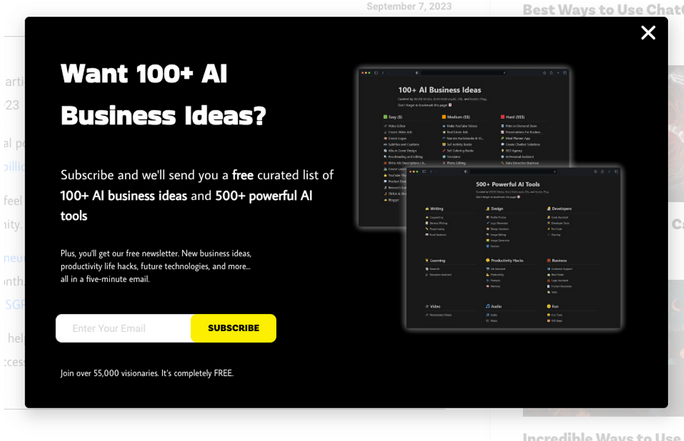
Here are a few tips to create a high-converting pop-up:
- Give something away for free: We send everyone who signs up a list of 500+ AI tools and 100+ AI business ideas. If life has taught me one thing, it’s that people love free stuff.
- Make it less annoying: Set it so the pop-up appears after 30-40s. That way, only people who are already interested in your content will see the pop-up. I chose that amount of time because the average user session on our website is just over 1 minute – adjust accordingly.
- Only ask for critical information: The less information you ask for, the better. I only ask for their email address. I could arguably ask for the first name, but it converts slightly worse.
- Be a scientist: Test, test, test. Keep making tweaks to the copy, the graphics, the timing – everything. Be a scientist and don’t ever stop optimizing
How long does it take to get subscribers using this strategy?
SEO is a long-term game. SEO can take 6-12 months to start seeing serious results. It’s tough, but those willing to put in the work are handsomely rewarded.
I want to learn more about growing a newsletter
If you’re interested in starting a newsletter business, make sure you subscribe to “The Newsletter Newsletter”. It shares weekly tips and tricks to grow your newsletter and make money from it. Some of the resources and freebies they have been sharing are insanely valuable.
Please note: Some of the links in this article may be affiliate links, which can provide compensation to us at no cost to you if you decide to purchase a paid plan. We only include links to high-quality products we’ve personally used.

